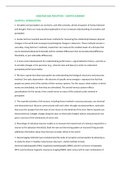Summary
Sensation and Perception UU - Chapter Summary (1-7)
- Course
- Institution
- Book
This short document is a summary of the most important points and theories mentioned in each chapter. It can help you a lot if you could not read the chapters and want to reinforce the content covered in the lectures and have a general idea of each chapter. , as it focuses on the most important con...
[Show more]




